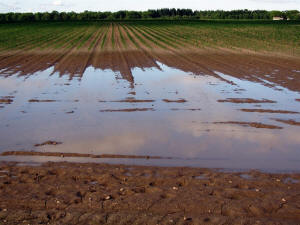Farm Bureau opposes nutrient loss bill as negotiations continue
 Send a link to a friend
Send a link to a friend
[March 03, 2022]
By BETH HUNDSDORFER
Capitol News Illinois
bhundsdorfer@capitolnewsillinois.com
 SPRINGFIELD – A bill meant to stem nutrient
pollution resulting from farm runoff has met opposition from a
formidable foe – the Illinois Farm Bureau – as negotiations on a final
package continue. SPRINGFIELD – A bill meant to stem nutrient
pollution resulting from farm runoff has met opposition from a
formidable foe – the Illinois Farm Bureau – as negotiations on a final
package continue.
Nutrient loss is one of the most serious pollution threats in the
country, creating a dead zone in the Gulf of Mexico, poisoning local
lakes and streams and causing serious health problems for people and
domesticated animals.
Illinois, a major contributor to nutrients in water, pledged to develop
strategies to reduce the nutrient loads leaving the border.
The state aimed to reduce nitrates and nitrogen by 15 percent and
phosphorus by 25 percent by 2025, but the latest Illinois Nutrient Loss
Reduction Strategy Implementation Report showed that nutrient loss
increased by 13 percent and phosphorus losses increased by 35 percent,
compared with a baseline period from 1980 to 1996.
The bill, Senate Bill 3471, was introduced in January, but was amended
in early February, changing substantively from its original form that
funded a program incentivizing the planting of cover crops by offering
discounts on crop insurance.
The amended bill creates the Healthy Soils and Watershed Initiative that
would be administered by the Department of Agriculture in cooperation
with the state’s soil and water conservation districts, the Illinois
Environmental Protection Agency, and the University of Illinois
Extension program.

The Department of Agriculture would create guidelines to help with soil
and water conservation districts to create a plan and establish funding
levels with “measureable, cost-effective and technically achievable
goals” to reduce nutrient loss.
The Initiative would then produce a study every two years, beginning in
2023, outlining efforts to combat nutrient loss and their overall
effectiveness. It would also measure the overall picture of nutrient
loss and whether the state was moving towards goals set out in the
Nutrient Loss Reduction Strategy.
Supporters say the bill creates a baseline to gauge the scope of the
problem and identify appropriate spending limits and strategies that
work, and it also provides accountability to taxpayers.
The information collected by the agencies would also make it easier to
obtain federal monies set aside to combat nutrient loss, said Maxwell
Webster, Midwest Policy Manager for America Farmland Trust, a proponent
of the bill.
The Illinois Farm Bureau voiced opposition to the bill in committee
hearing because they say it is duplicative, complicated and
bureaucratic.
The Farm Bureau said the bill put various state and federal agencies,
authorities, and programs under one umbrella, making it difficult to
implement. Adding provisions to already existing laws, like the Soil and
Water Conservation Act, would make the Nutrient Loss Reduction
Strategies less confusing and eliminate bureaucracy, said Lauren Lurkins,
Director of Environmental Policy for the Illinois Farm Bureau.
[to top of second column]
|

The Illinois Farm Bureau is opposing a bill aimed at
addressing nutrient runoff on farms as negotiations continue on a
final proposal. (Credit: https://pixabay.com/photos/fields-field-flooding-wetness-406153/)

“We believe that the current NLRS program is moving us in the direction
of protecting the environment and helping farmers better manage their
land and resources,” Lurkins wrote in an email. “SB 3471 has some great
ideas in the proposed language, but does it in a way that is awkward and
duplicative. We feel that there are many laws in place that can be
changed to include the goals that this bill lays out in a more efficient
and workable format.”
The Farm Bureau also voiced its opposition to mandates, stating that
voluntary implementation will make the programs more palatable to
farmers.
The bill is not designed to increase regulation and it does not create
additional mandates. It is focused on making sure the state maximizes
existing resources and successfully attracts additional investment from
the federal government, Webster said.
“Mandates are not the answer to this problem. Farmers are our greatest
stewards of the land and the focus needs to be on getting more resources
in their hands to implement conservation practices,” Webster said.
“That’s why this bill seeks to update our existing voluntary
conservation programs so that they are more responsive to the needs of
farmers and the goals of the nutrient loss reduction strategy while also
addressing emerging challenges like climate change.”
The bill states “the initiative shall promote voluntary and
incentive-based conservation efforts. No part of this act shall be used
to impose mandates or require practice adoption.”
The original bill proposed an increase in funding for nutrient loss
reduction policies over the next 10 years from $10 million to more than
$25 million in 2027, extending through 2032, but that language was
removed in the latest Senate amendment.
The original bill would also have expanded the eligible uses for the
Partners for Conservation Fund, including funding the Fall Covers for
Spring Savings Program. But that language was also stripped from the
bill in Senate Amendment 1.
The funding mechanism of that program will now be spread out across IDOA,
IDNR and IEPA in wider appropriation discussions, but the funding
request for the cover crop program is the same as in the last bill.
“We look forward to working with Sen. Ram Villivalam (D-Chicago) and the
other stakeholders of this legislation to work out all the
technicalities of the legislation,” Lurkins said.

Advocates for the bill said they are hopeful it will be able to move
when the Senate returns next week, as the deadline for its passage was
extended to March 11.
It passed the Senate Agriculture Committee on an 8-6 vote last month,
with only Democratic support. Committee chair Patrick Joyce, D-Essex,
was the lone Democrat to oppose the bill in committee, joining
Republicans in voting against it.
Capitol News Illinois is a nonprofit, nonpartisan news service covering
state government and distributed to more than 400 newspapers statewide.
It is funded primarily by the Illinois Press Foundation and the Robert
R. McCormick Foundation. |